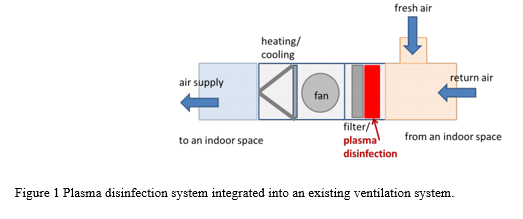Description:
Princeton Docket # 21-3764
Motivated by the current COVID-19 pandemic, Researchers at Princeton Plasma Physics Laboratory, Princeton University, have designed a novel plasma-based in-situ device for decontaminating air flow from viruses and bacteria in real time. The use of cold, low temperature plasma to eradicate pathogens is a tested and effective technology. The Princeton device is a new steady state approach to continuously decontaminate air in ventilation systems with heating and/or air conditioning without inducing thermal or other damage.
This technology uses atmospheric plasma discharge technology for the purpose of producing cold non-equilibrium plasma(s) directed toward the targeted surface. The device can easily be made into a desirable geometry. The device is very simple in operation, constructed from inexpensive components, and powered by a simple and compact power source.
Applications:
- Use in residential and commercial buildings, including hospitals
- Add-on to air ventilation systems with heating and/or air-conditioning with recirculation
- Use as part of a portable air decontamination system including hospital rooms
Advantages:
- Kills bacteria and viruses
- Not subject to the “shadow” problem of UV disinfection
- No chemicals required
- Operates continuously
- Simple to operate
- Constructed from inexpensive components
- Powered by a simple and compact power source

The U.S. Department of Energy's Princeton Plasma Physics Laboratory is a Collaborative National Center for plasma and fusion science. Its primary mission is to develop the scientific understanding and the key innovations which will lead to an attractive fusion energy source. Associated missions include conducting world-class research along the broad frontier of plasma science and providing the highest quality of scientific education.
Inventor
Shurik Yatom is a Staff Research Physicist at the Princeton Plasma Physics Laboratory. He received his BS and PhD in Physics from Technion-Israel Institute of Technology in 2008/2013. His PhD thesis was focused on research of nanosecond discharges in gases at atmospheric and higher pressures and has received several prestigious awards, such as: 2014 Igor Alexeff Outstanding Student Award of the Plasma Science and Application Committee (PSAC) of the IEEE, 2013 Israel Physical Society Prize for graduate student in Experimental Physics, IEEE Arthur H. Guenther Pulsed Power student award 2012 and Jacobs Excellence Fellowship 2011-2012. From 2014-2016 he worked in the University of Minnesota in the department of Mechanical Engineering, where he was working on laser scattering and fluorescence diagnostics of atomic and molecular species in non-equilibrium plasmas. At PPPL Dr. Yatom is engaged in a wide variety of activities including developing and studying plasma sources for biomedical applications, plasma-assisted synthesis of nanomaterials, development and application of plasma and nanomaterial diagnostics among others.
Intellectual Property Status
Patent protection is pending.
Princeton is currently seeking commercial partners for the further development and commercialization of this opportunity.
Contact
Chris Wright
Princeton University Office of Technology Licensing • (609) 258-6762• cw20@princeton.edu
Laurie Bagley
Princeton Plasma Physics Laboratory • (732) 991-7811 • lbagley@pppl.gov